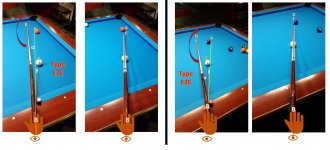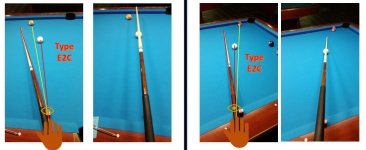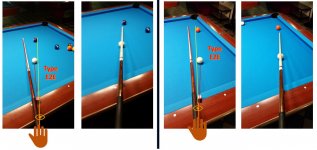Hi everybody,
Basically my new aiming system has only two types of reference lines: Edge 2 Edge and Edge 2 Center (from the player’s perspective).
Afterwards, the player has to position himself at the table accordingly and from that standing position he is able to pocket the OB without looking at where the hole is, either pivoting to the cue to the center of CB.
In particular, the pocket represents only a guideline to choose which shot class applies (E2E or E2C).
The back hand is the pivot to the shot.
I’m quite happy to have developed this simple aiming system which is effective and based on the following assumption:
In each shot the player must always have the E2E or E2C visuals. As long as you see those visuals when you are approaching the CB, with the tip of CB in the center of the CB, you are certain that you can pocket the OB.
This system allows the player to obtain those visuals when he is delivering the shot on the table.
(The pictures and the explanation that follow are referred to a right-handed player).
Hope to hear your test results.
Cheers,
Salux
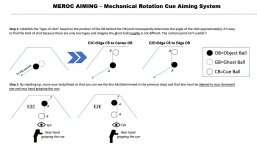

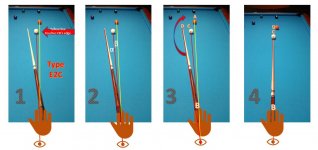

Basically my new aiming system has only two types of reference lines: Edge 2 Edge and Edge 2 Center (from the player’s perspective).
Afterwards, the player has to position himself at the table accordingly and from that standing position he is able to pocket the OB without looking at where the hole is, either pivoting to the cue to the center of CB.
In particular, the pocket represents only a guideline to choose which shot class applies (E2E or E2C).
The back hand is the pivot to the shot.
I’m quite happy to have developed this simple aiming system which is effective and based on the following assumption:
In each shot the player must always have the E2E or E2C visuals. As long as you see those visuals when you are approaching the CB, with the tip of CB in the center of the CB, you are certain that you can pocket the OB.
This system allows the player to obtain those visuals when he is delivering the shot on the table.
(The pictures and the explanation that follow are referred to a right-handed player).
Hope to hear your test results.
Cheers,
Salux




Last edited:
